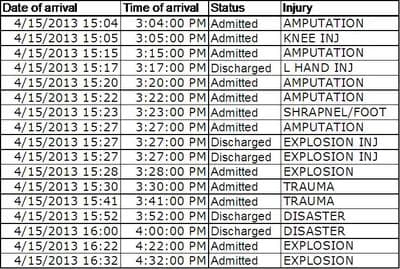Advertisement
Fateful Boston Marathon Photo: Mass. General's ER At 4:15 On 4/15

A Boston Marathon jacket from the race three years earlier hangs over one chair, a white coat over another. One staffer looks on, head in hand. Another stands with hands on hips. Some are checking their phones, trying to triangulate the triage they've been treating, or are readying to treat. They've already shimmied into surgical gowns over their scrubs.
It's 4:15 pm on 4/15, Patriots' Day, Marathon Monday.* It's the eye of the storm in the emergency department at Massachusetts General Hospital.
Snapped by associate chief of psychiatry at MGH John Herman, the photo captures the nerve center of the hospital's emergency department after the initial rush of marathon bombing patients.
Not long before, the department's day-shift staff was going through a routine protocol: the daily hand-off to the evening shift that takes over at 3:00 p.m.
The bombs were not routine. They both detonated a little more than a mile away, a zigzag away through a marvelous city in spring bloom, on Boylston Street, at 2:50 p.m.
At 2:55, Boston EMS notified Mass. General and other Boston-area hospitals to be prepared for mass casualties. MGH activated its "Code" disaster plan. That was at 3:03 p.m.
One minute later, at 3:04, the first patient arrived in a police van.
Amputation.
Over the next hour, the emergency staff treated 14 more patients. More amputations. Shrapnel wounds. Burns. A stream of critically injured civilians, some in cardiac arrest, that MGH's president, Peter Slavin, called "unprecedented in our history."

Each critical patient was moved to an operating room within minutes, while others were treated in bays adjacent to the central room of the emergency department pictured here.
When the fateful photo above was snapped about 4:15 pm, the first rush had passed. The medical professionals shown in the photo don't know that another 24 patients are on their way.
The injuries for the next two, at 4:22 and 4:32 p.m., were described in the emergency department admittance log simply as "EXPLOSION." Patients who came in after that tended to have shrapnel wounds, blown ear drums or hearing issues. Some suffered from incapacitating anxiety.
In all, Massachusetts General Hospital treated 39 bombing patients on April 15, 2013. Twelve were hospitalized at least overnight. Eight were critically injured.
They all survived.
And one reason is visible in this photograph: a digital click that grabs more than two dozen medical professionals standing by.
There are so many at the ready, thanks to the luck of the timing, coming right at shift change. But they also made their own luck: Some in the photo came down to the first floor from other areas of the hospital.
When this photo was taken, their colleagues are in operating rooms, fighting to save lives and limbs. Some bombing victims are within eye-and-earshot in adjacent patient bays. But those patients are being taken care of. They’re not the responsibility of the people pictured here.
Their responsibility is the next wave.
Any moment, it will be here.
*One digital clock pictured displays 4:15 p.m; another appears to show 4:18 p.m.
This program aired on June 5, 2013. The audio for this program is not available.
